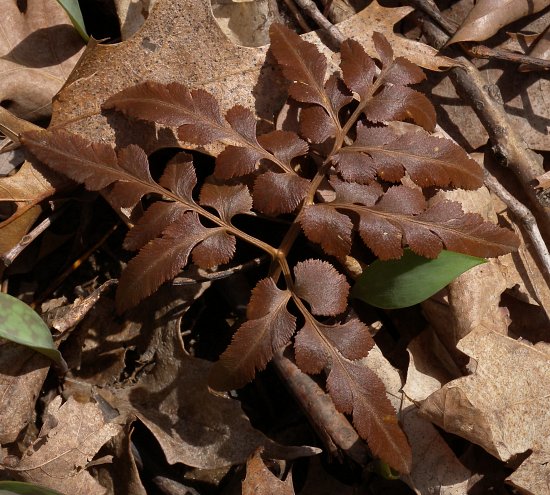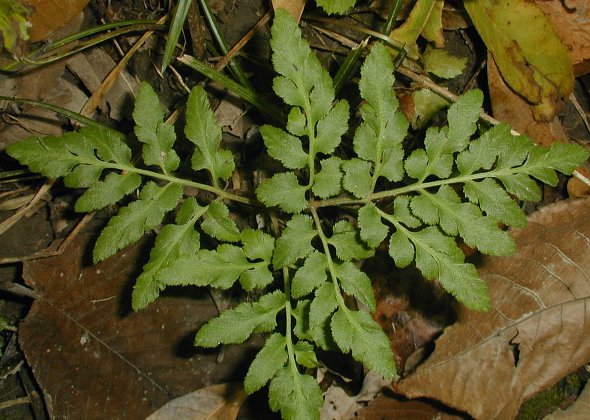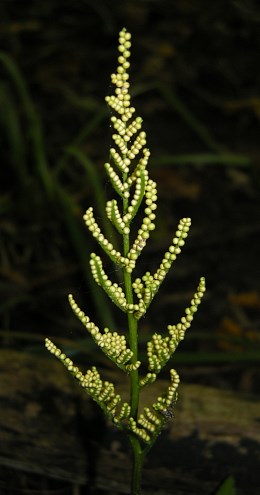Description: This perennial fern consists of a single sterile leaf and a single fertile leaf that bears the spores; the latter is not always produced. When both types of leaves are present, they are joined together at the bases of their petioles; this typically occurs close to the ground. The blade of the sterile leaf is bipinnate-pinnatifid or tripinnate-pinnatifid in its structure; it spans up to 6" long and 6" across. This blade is divided into 1-3 major divisions; each division has a deltate shape in outline, a bipinnate-pinnatifid structure, and a short stalk at its base. Each major division of the sterile leaf has up to 7 pairs of leaflets; the lower leaflets are stalked, while the upper leaflets are sessile. The lower leaflets and some of the upper leaflets are divided into up to 7 pairs of subleaflets that are oval to oblong-lanceolate in shape; usually the terminal subleaflets are larger and more elongated than the lateral subleaflets. The subleaflets and undivided upper leaflets have finely serrated or crenate margins; sometimes they are irregularly cleft into smaller lobes. The sterile leaf blade is evergreen; it is medium green during the autumn, but becomes bronze-colored during the winter (hence the common name). The petiole of the sterile blade is 2-6" long, light green or light bronze, and slightly succulent; both the sterile blade and its petiole are glabrous.

The
fertile leaf blade has a very different appearance from the sterile
blade; this blade has a bipinnate or tripinnate structure, but it is
contracted into sporangia-bearing branches. The fertile leaf blade is
up to 8" long and 4" across (excluding its petiole); this leaf blade is
initially medium green, but it later becomes tan or brown.
The lateral branches and tip of the fertile blade bear dense rows of
small
globoid sporangia that are yellow; both the fertile leaf blade and
sporangia are glabrous. During the late autumn or winter, the sporangia
split open to release their minute spores to the wind. The petiole of
the fertile leaf is 6-12" long; it is light to medium green, glabrous,
and slightly succulent. The root system consists of fibrous roots
that are fleshy and shallow.
Cultivation:
The preference is partial sun to medium shade, moist to dry-mesic
conditions, and soil that contains loam or some rocky
material. Because the root system is partially dependent on
mycorrhizal fungi in the soil, this fern does not adapt to cultivation
readily and it is unlikely to survive transplantation from a natural
area. The life cycle of this fern begins during the autumn, when new
leaves (both fertile and infertile) are produced as the canopy trees
shed their leaves. The infertile leaves remain alive during the entire
winter, although they become bronze-colored in response to
below-freezing temperatures. These leaves finally wither away during
the spring, and the fern persists in a dormant state during the summer,
until the same cycle repeats itself beginning in the following autumn.

Range &
Habitat:
The native Bronze Fern is occasional throughout Illinois (see Distribution
Map).
Habitats include deciduous woodlands, open woodlands, thinly wooded
bluffs, upland savannas, areas along woodland paths, grassy meadows,
shaded gravelly seeps, and pastures. This fern is found in upland
woodlands
where either oak trees (Quercus
spp.) or maple trees (Acer
spp.) are dominant.
Faunal Associations:
Information about floral-faunal relationships is very limited. The Wild
Turkey has been found to eat the fronds of Botrychium
spp. (Grape Ferns) to a limited extent; the Ruffed Grouse and
White-Tailed Deer probably eat the fronds as well.
Photographic Location:
The photograph of the sterile green leaf was taken along a path in
an upland oak woodland in McLean County, Illinois, while the photograph
of the fertile leaf and the photograph of the sterile bronze leaf were
taken at Busey Woods in Urbana, Illinois.

Comments: The Bronze Fern has a very different appearance from the typical variety of this species, Botrychium dissectum dissectum (Cutleaf Grape Fern); the latter has conspicuous dentate margins and shorter terminal leaflets or subleaflets. However, both varieties of this species become bronze during the winter. Other similar Botrychium spp. (Grape Ferns) have sterile leaves that remain green during the winter; they are less common and more restricted in their distributions within the state. Another species, the common Botrychium virginianum (Rattlesnake Fern), has deciduous sterile leaves that are larger in size and divided into more numerous leaflets and subleaflets. This latter fern also has sessile sterile leaves that share the same stalks with the fertile leaves when the latter are present. An alternative scientific name of the Bronze Fern is Botrychium obliquum. Another common name of this species is the Common Grape Fern.